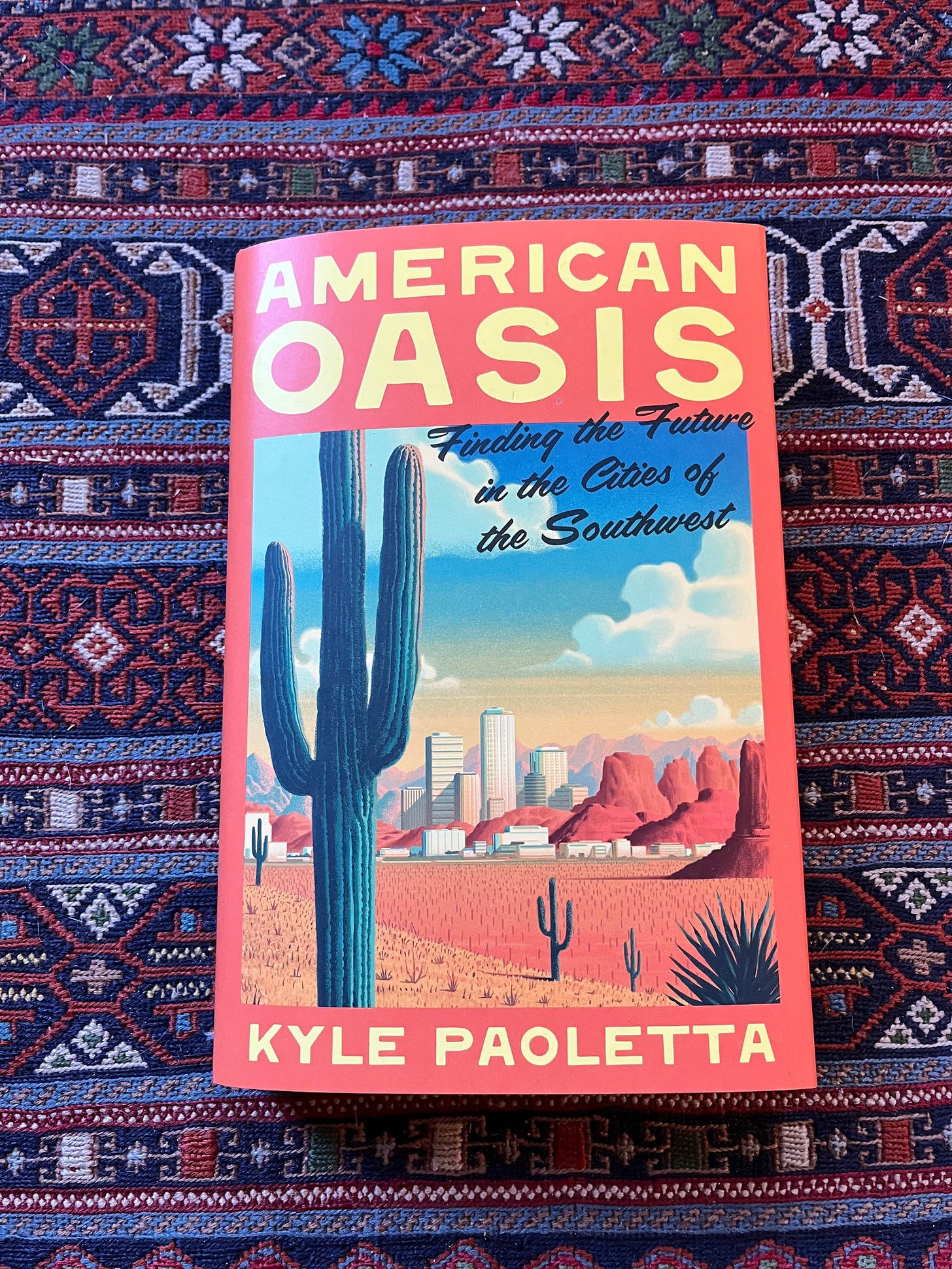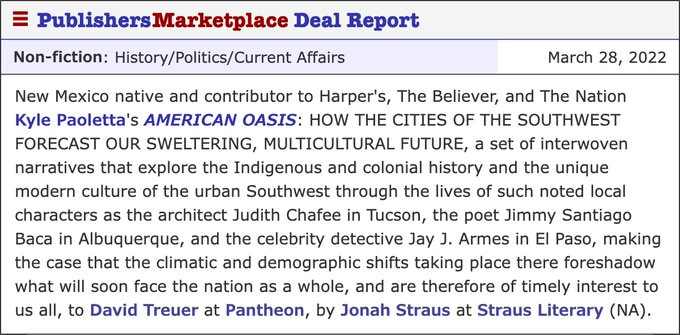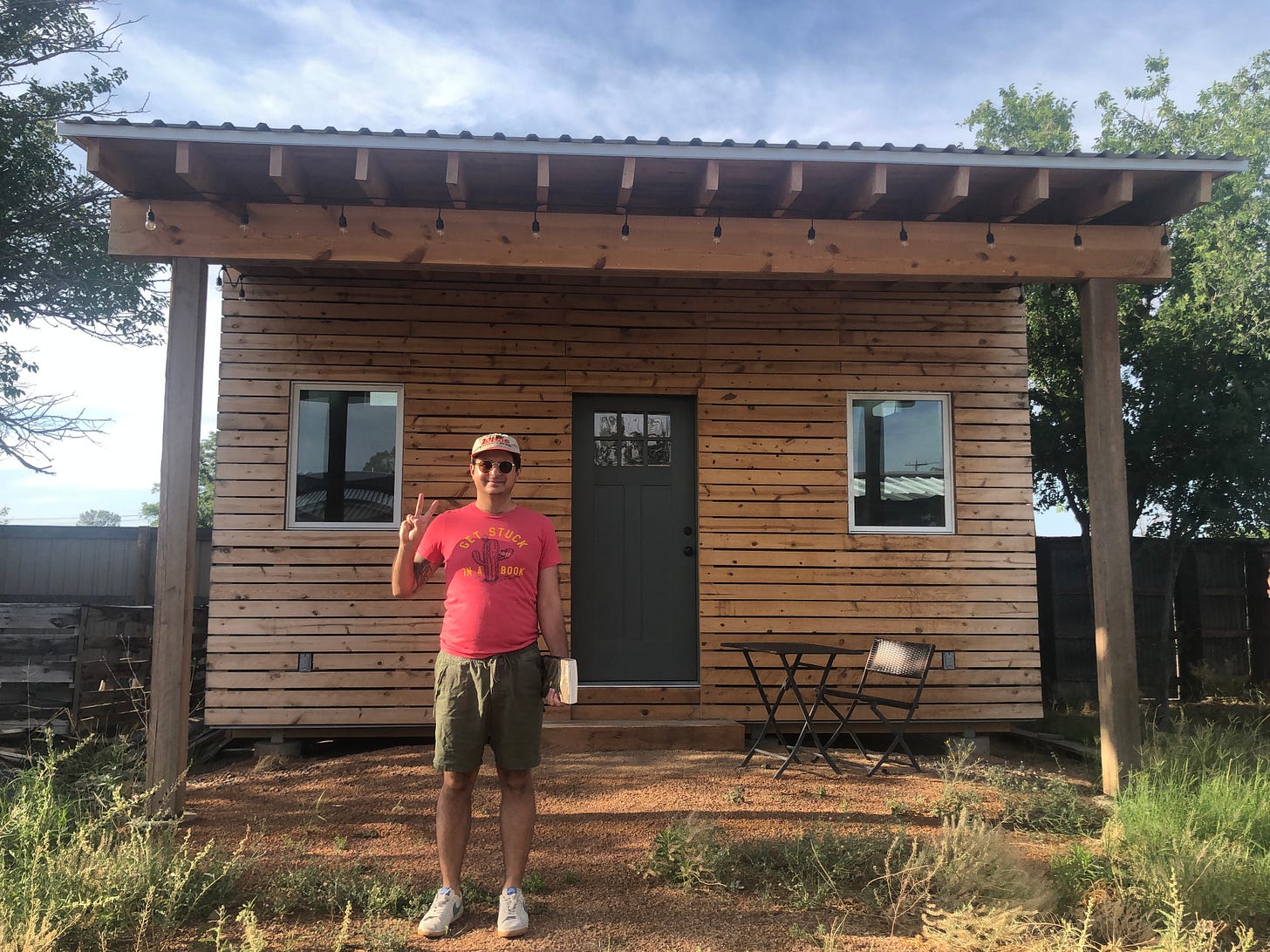How to Write a Book
American Oasis: Finding the Future in the Cities of the Southwest is out now
First, you need an idea. The first glimmer of what would become American Oasis came to me in February 2019, when Tess and I were visiting our friend Sreshtha in Las Vegas. After we had breakfast in the Arts District, we took a walk down Charleston Boulevard to Savers. Far from the Strip, I had an uncanny sense memory of walking in Albuquerque as a teenager. The bulk of Las Vegas, I realized, felt just like the Northeast Heights. For cities with such drastically different places in the national — make that global — imagination, it was impossible to ignore the fact that they were both fundamentally Southwestern cities, places birthed from and in constant conversation with the desert. But that realization begged another, deeper question. What, exactly, was a desert city anyway?
For the next two years, I kept mulling over what it meant to be from a city in the Southwest as I traveled around the region on a handful of reporting trips. That question led me to write an essay on the culture of the city Southwest for The Believer and to investigate the history of a magazine called Arizona Highways that I kept bumping into everywhere from Airbnbs to the Flagstaff public library to the Phoenix Sky Harbor for Columbia Journalism Review. At the same time, I was getting up to speed on how climate change was draining the Southwest’s water reserves, leading to my report for New York Magazine about the fight over the Colorado River and an essay for The Nation about the history of the Salton Sea.
By the spring of 2021, I finally had enough material to start putting all the pieces together into a book proposal. I had previously made contact with a couple of agents when I was shopping around the novel I wrote in grad school. Luckily, Jonah Straus loved the new idea for a nonfiction book about the lessons that the Southwest could teach the rest of the nation in the era of climate crisis.
Jonah helped me get the book proposal into fighting shape over the next six months. Then came another few months of shopping the book proposal around to editors at publishing houses. Another stroke of luck: David Treuer, who I’d previously gotten to know while fact-checking his irreplaceable history of Native America, The Heartbeat of Wounded Knee, joined Pantheon as an editor-at-large midway through the submission phase. While other editors were intrigued by the premise of American Oasis, David was the only one who immediately understood our vision for the project and shared my desire to not only help the rest of the country understand the Southwest, but help Southwesterners better understand themselves.
I signed on with Pantheon in the spring of 2022, more than three years after I’d started thinking about what sort of book I wanted to write. With just one year to deliver American Oasis, I jumped into reporting mode, flying out to El Paso for my first reporting trip before I’d even gotten my first advance payment. Speaking of, my advance was split into four parts, and I knew that I’d need to spend more than half of that first payment on reporting. That meant that 2022 was a blur of travel, with me having to split focus between working on the book and the freelance stories I was continuing to rely on to pay my share of our household’s bills. After El Paso, I spent a couple weeks in Phoenix and Tucson, then went home to Albuquerque, before jetting off to Las Vegas for my last trip of the year.
I gave myself six months to report the book and six months to write it. That means that the first half of 2023 was by far the most intense burst of sustained writing I’ve ever done in my life. To hit my June deadline, I had to write 5,000 words a week — the equivalent of a feature-length magazine story. Somehow, that happened. (I seriously don’t remember this period at all, though Tess wrote a guest newsletter that should flesh things out if you’re interested!) With a rough first draft in hand, I headed to Marfa to finish the book, as Rachel Monroe had graciously offered me her house as a writing retreat while she was off reporting something spectacular for the New Yorker.
I hit my deadline, filing the first draft of American Oasis on June 1st, 2023. For the next few months, I got back to freelancing while David and the other editors at Pantheon reviewed it. In September, I finally heard the word that, while the meat of the book was good, it needed a major structural overhaul. Queue two months of revisions to get everything straightened out (very much for the better), as well as a month of putting together the endnotes and bibliography — yes, that took a month.
As you can imagine, the end of 2023 was not a particularly pleasant time in the book’s life cycle, however necessary. It was made more stressful by the inherent ambiguity of most book contracts when it comes to when the second advance payment is released. In my contract, I’m paid upon signing, upon “acceptance” of the manuscript by the publisher, upon publication, and one year after publication. “Acceptance” does not mean delivery, so while I may have hoped to get my second advance payment at some point in the summer after I turned in the first draft, I didn’t actually get it until the second draft was accepted in February 2024 (and many, many thanks to David for intervening to ensure I was paid then rather than having to wait until I polished up a third draft). I was able to get by in the intervening months via freelance jobs and drawing on my savings, but this is very much the sort of vagary of the publishing industry that most folks only learn about when they’re in the middle of trying to, you know, write a book. So, aspiring authors, please heed me: delivery does not equal acceptance!
The manuscript accepted, things started to happen very quickly. I saw the first mock-up of the cover art in March 2024 and had to turn around a final round of edits in April. After I got a copy edited manuscript back in June, I began sending it out to friends in the business for a first round of blurbs (with the great Andy Borowitz stepping up with a real barn-burner that I believe encouraged lots of other folks to take a look at an advance copy who may not have otherwise). I got my first glimpse of the printed book when an ARC arrived in August, then finalized the manuscript and began planning publicity the same month, with Pantheon really stepping up to finance a book tour that’s quite extensive compared to what many debut authors receive.
Which brings us to… now. Today. American Oasis: Finding the Future in the Cities of the Southwest is now being sold all over the country, in independent bookstores and online. I have a profound sense of gratitude to Jonah, David, and all the other folks at Pantheon and beyond who have helped get the book to this point. At the same time, looking back I’m dumbfounded by how much work it was to write this book, from conceptualizing it to proposing it to reporting it to writing it to revising it to revising it again to revising it a third time to this new, strange phase of publicizing it. Six years is a not insignificant fraction of my entire life. I’m unbelievably proud to have spent it on a book that reflects my love of the place I come from and desire for Americans everywhere to forge a more sustainable future.
How do you convince yourself to spend six years working on a book? Honestly, I don’t have a great answer for that, so I’ll share a memory instead. When I was finishing grad school at Columbia, I went to a panel of alumni and professors who were talking about the strange business of making a living as a writer. One of the speakers was Rivka Galchen — by then we were already friends, so perhaps that’s why I paid closer attention to her words than the other people on the panel. In any case, I remember her saying something like: “Everyone I know from grad school who wanted to publish a book — who really kept at it no matter what else was going on in their life — all of them ended up publishing a book. For some people it takes years, but if you keep at it, it will happen.”
Keep at it. It will happen. For a writer with a dream, that’s honestly all there is to say.
The book tour starts today! Tonight I’ll be at Harvard Book Store talking with Sierra’s Julia Sklar — one of my favorite editors in the business — at 7pm. Check the nifty graphic above for the rest of my book tour stops in January. I’ll also be doing some more traveling in March and April for the Tucson Festival of Books, the San Antonio Book Festival, and the Society of Environmental Journalists’ conference in Phoenix, so I’m excited to share details about those events once we get closer to the spring.
The reviews are starting to pour in and I couldn’t be happier with the reception American Oasis is receiving, particularly from the Washington Post, the Los Angeles Times, and the San Francisco Chronicle. I’ve also been doing an interview basically every day for the last week and a half, and those are starting to trickle out as well. Check out my conversation with Sam Dingman from KJZZ in Phoenix that aired yesterday, and tune into The Book Show from WAMC on Thursday for my interview with Joe Donahue. If you’re in Santa Fe, I’ll be on KTRC’s Coffee and Culture with Matthew Chase-Daniel this weekend, which is also when my print interview with the Albuquerque Journal’s David Steinberg should be running. Lots more podcasts appearances and interviews on the way, which I’ll be sharing as they come out on Twitter, BlueSky, and Instagram.
That’s more than enough for now. Thanks, as always, for your readership and support. Dang, I guess I’m an author now, huh?
Your pal,
Kyle







